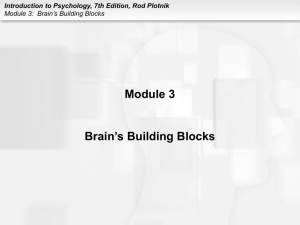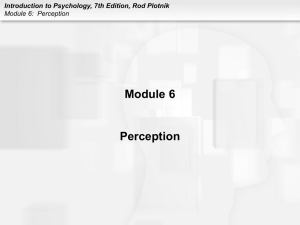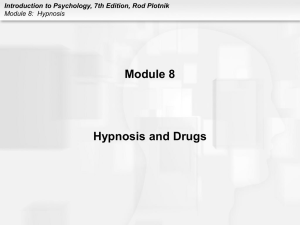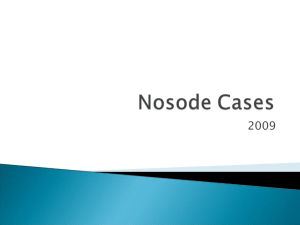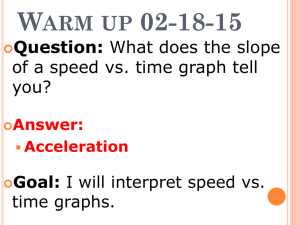MODULE 5
advertisement
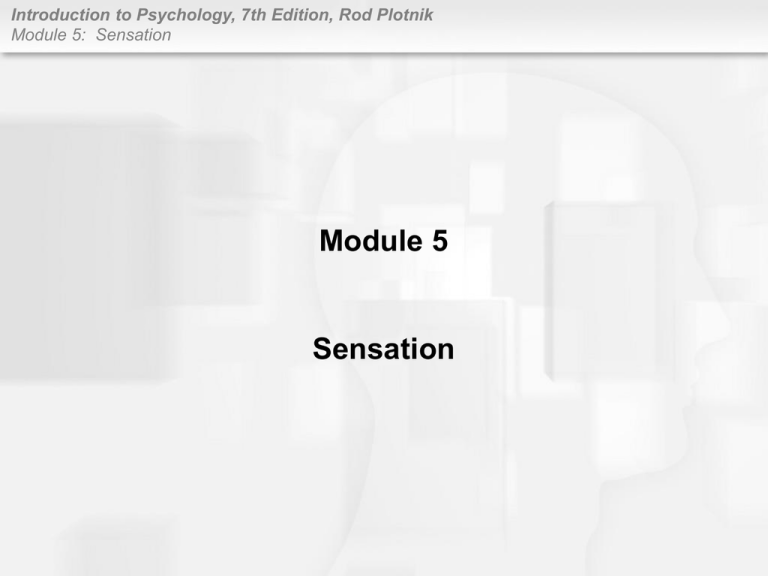
Introduction to Psychology, 7th Edition, Rod Plotnik Module 5: Sensation Module 5 Sensation Introduction to Psychology, 7th Edition, Rod Plotnik Module 5: Sensation Sensations Sensation is direct input from sense organs – Vision – Hearing – Vestibular system – Taste – Olfaction – Touch Introduction to Psychology, 7th Edition, Rod Plotnik Module 5: Sensation EYE: VISION • Structure and function 1. Gather and focus light 2. Absorb and transform light waves into electrical impulses – process called transduction Introduction to Psychology, 7th Edition, Rod Plotnik Module 5: Sensation p95 EYE Introduction to Psychology, 7th Edition, Rod Plotnik Module 5: Sensation EYE: VISION • Structure and function – Vision: 7 steps • Image reversed/Light waves • Cornea • Pupil • Iris • Lens • Retina Introduction to Psychology, 7th Edition, Rod Plotnik Module 5: Sensation EYE: VISION • Structure and function – Cornea • bends and focuses light waves into a narrower beam of light – Pupil • allows light waves to pass into the eye’s interior Introduction to Psychology, 7th Edition, Rod Plotnik Module 5: Sensation EYE: VISION • Structure and function – Iris • controls the amount of light entering the eye – Lens • bends and focuses light waves into an even narrower beam Introduction to Psychology, 7th Edition, Rod Plotnik Module 5: Sensation EYE: VISION • Structure and function – Retina • extremely sensitive to light • begins the process of transduction by absorbing light waves Introduction to Psychology, 7th Edition, Rod Plotnik Module 5: Sensation p96 RETINA Introduction to Psychology, 7th Edition, Rod Plotnik Module 5: Sensation EYE: VISION • Visual pathways: Eye to brain – Optic nerve – Primary visual cortex – Visual association areas Introduction to Psychology, 7th Edition, Rod Plotnik Module 5: Sensation p97 VISUAL SYSTEM Introduction to Psychology, 7th Edition, Rod Plotnik Module 5: Sensation EYE: VISION • Visual pathways: eye to brain – Optic nerve • nerve impulses flow through the optic nerve as it exits from the back of the eye to the brain • the exit point is the “blind spot” (Why don’t you notice the blind spot?) • the optic nerves partially cross and pass through the thalamus • the thalamus relays impulses to the back of the occipital lobe in the right and left hemisphere Introduction to Psychology, 7th Edition, Rod Plotnik Module 5: Sensation Leading a person who is blind • • • • Offer your assistance Keep the person on the leader’s left Allow the person to take your arm Give clear/brief/accurate information People who are blind respond well to intelligence Demonstrate veering Introduction to Psychology, 7th Edition, Rod Plotnik Module 5: Sensation Visual Impairment and the Artificial Eye Introduction to Psychology, 7th Edition, Rod Plotnik Module 5: Sensation EAR: AUDITION • Measuring sound waves – decibel: unit to measure loudness – threshold for hearing: • 0 decibels (no sound) • 140 decibels (pain and permanent hearing loss) Introduction to Psychology, 7th Edition, Rod Plotnik Module 5: Sensation Introduction to Psychology, 7th Edition, Rod Plotnik Module 5: Sensation EAR: AUDITION – Outer ear function – pick up sound waves and then send them down the auditory canal Introduction to Psychology, 7th Edition, Rod Plotnik Module 5: Sensation EAR: AUDITION • Outer, middle, and inner ear – Inner ear • contains two structures sealed by bone – cochlea: involved in hearing – vestibular system: involved in sensing the position of the head, keeping the head upright, and maintaining balance Introduction to Psychology, 7th Edition, Rod Plotnik Module 5: Sensation CHEMICAL SENSES (CONT.) • Tongue – Five basic tastes • sweet • salty • sour • bitter • umami: meaty-cheesy taste Introduction to Psychology, 7th Edition, Rod Plotnik Module 5: Sensation CHEMICAL SENSES (CONT.) • Taste buds – shaped like miniature onions – receptors for taste – chemicals dissolved in saliva activate taste buds – produce nerve impulses that reach areas of the brain’s parietal lobe – brain transforms impulses into sensations of taste Introduction to Psychology, 7th Edition, Rod Plotnik Module 5: Sensation CHEMICAL SENSES (CONT.) • Smell, or olfaction – Olfaction • called a chemical sense because its stimuli are various chemicals that are carried by the air • Function of olfaction – receptors, through transduction, transform chemical reactions into nerve impulses Introduction to Psychology, 7th Edition, Rod Plotnik Module 5: Sensation p107 OLFACTORY BULB Introduction to Psychology, 7th Edition, Rod Plotnik Module 5: Sensation CHEMICAL SENSES (CONT.) • Smell, or olfaction – Sensations and memories • nerve impulses travel to the olfactory bulb • impulses are relayed to the primary olfactory cortex • cortex transforms nerve impulses into olfactory sensations • Can identify as many as 10,000 different odors • we stop smelling our deodorants or perfumes because of decreased responding • called adaptation Introduction to Psychology, 7th Edition, Rod Plotnik Module 5: Sensation CHEMICAL SENSES (CONT.) • Smell, or olfaction – Functions of olfaction • one function: to intensify the taste of food • second function: to warn of potentially dangerous foods • third function: elicit strong memories; emotional feelings Introduction to Psychology, 7th Edition, Rod Plotnik Module 5: Sensation Smell Memory Introduction to Psychology, 7th Edition, Rod Plotnik Module 5: Sensation TOUCH • Touch – includes pressure, temperature, and pain Introduction to Psychology, 7th Edition, Rod Plotnik Module 5: Sensation p108 SKIN Introduction to Psychology, 7th Edition, Rod Plotnik Module 5: Sensation TOUCH (CONT.) • Receptors in the skin – skin – hair receptors - when first bent (after being bent=sensory adaptation) – free nerve endings – temperature and pain – Pacinian corpuscle – vibrations Somatosensory cortex (parietal lobe) – transforms nerve impulses into sensations of touch temperature, and pain Introduction to Psychology, 7th Edition, Rod Plotnik Module 5: Sensation PAIN • What causes pain? – pain: unpleasant sensory and emotional experience that may result from tissue damage, one’s thoughts or beliefs, or environmental stressors – pain results from many different stimuli Introduction to Psychology, 7th Edition, Rod Plotnik Module 5: Sensation p112 BRAIN PAIN Introduction to Psychology, 7th Edition, Rod Plotnik Module 5: Sensation PAIN (CONT.) • How does the mind stop pain? – gate control theory of pain – nonpainful nerve impulses compete with pain impulses in trying to reach the brain – creates a bottleneck or neutral gate – shifting attention or rubbing an injured area decreases the passage of painful impulses – result: pain is dulled Introduction to Psychology, 7th Edition, Rod Plotnik Module 5: Sensation PAIN (CONT.) • Endorphins – chemicals produced by the brain and secreted in response to injury or severe physical or psychological stress – pain reducing properties of endorphins are similar to those of morphine – brain produces endorphins in situations that evoke great fear, anxiety, stress or bodily injury as well as intense aerobic activity

